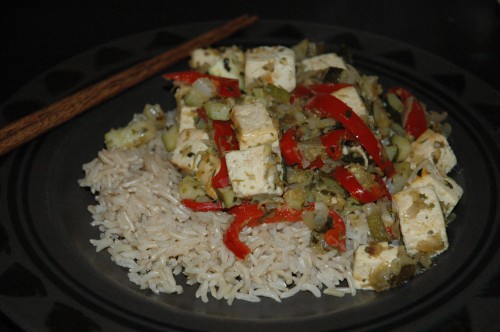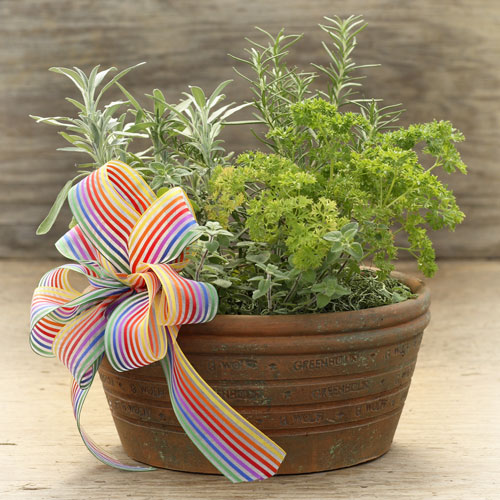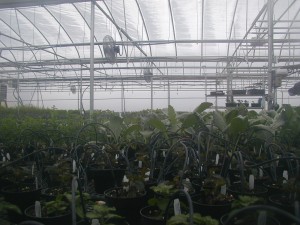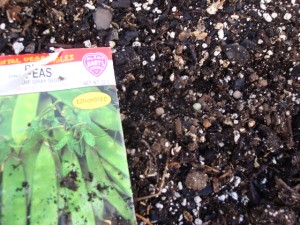by Herb Exchange | Nov 15, 2010 | Herbs, Miscellaneous, Recipes |

With dropping autumn temperatures, there’s nothing like a nice zesty dish to warm up your night. Give this recipe a whirl, utilizing three of our favorite herbs. It has quite a unique tang to it, combining lots of fresh mint and jalapeno peppers. If you prefer, this dish would also be great with chicken instead of tofu.
Vegetable Citrus Mint Stir Fry
Ingredients:
1 tbsp Olive Oil
3-4 Garlic Chives, minced
1 block firm or extra firm Tofu, well pressed
1 Red Bell Pepper, sliced
½ Onion, diced
1 Zucchini, chopped
4 stalks Lemon Grass, well minced in a food processor
2 tsp Sugar
½ tsp Salt
1 tbsp fresh Ginger, minced
1 Jalapeno, minced (or to taste)
1 ½ cups packed Citrus Kitchen Mint leaves
1 tbsp Rice Wine Vinegar (or White Wine Vinegar)
pre-cooked Rice
Preparation:
Sautee the garlic, tofu, red pepper, and onion for about 5 minutes. Add the zucchini, and continue to cook until the veggies are soft and the tofu is golden brown.
Remove from heat.
For sauce, place the remaining ingredients (except rice) in a food processor and process until mint is finely minced.
Add sauce to the tofu and veggies and reheat, just until hot. Serve over rice.
by Briscoe White | Aug 31, 2010 | Growing, Herbs |

This fall we have decided to add forty new herbs to our list. Some are new and some we have only grown for spring in the past, but now are offering in fall for window sill gardening and those in the Deep South who have little fear of freezing temperatures.
A South or West facing window with no obstructions to the sun offer the best opportunity. One of the hardest herbs to give up each fall is Basil. After enjoying fresh Basil all summer, many gardeners will preserve some by freezing. This allows one to continue making Pesto throughout the colder months, but is not quite as good as using fresh leaves. Why not keep an indoor Basil for picking and save the other for winter’s harsher months when Basil just will not grow fast enough to pick.
Italian oregano and Parsley are two good choices for indoor growing. They do not mind cooler temperatures and will continue to grow as long as they receive enough sunlight. These herb plants fit nicely in pots and so can occupy a sunny window sill easily.
Using a six inch pot, plant your indoor garden before the long days of late summer are over. This will allow the plants to grow enough to allow cutting later. During the short days of winter, the plants will not be able to grow fast enough to cut often. By planting early, you are basically growing while the growing is good and later maintaining the plants through winter. Unless one has very powerful grow lights, the plants will not be able to cut foliage until spring. In effect this method is storing fresh herbs “ on the hoof” for winter harvest.
By the end of winter the plants will be cut down with little foliage, but they will also begin regrowth as days begin to lengthen in early spring, giving an early crop long before outdoor herbs begin their spring growth. It may not be possible to enjoy limitless fresh cut herbs from indoor plants, but used sparingly will help fight cabin fever by providing flavor for special meals.
by Briscoe White | Aug 9, 2010 | Growing, Herbs |
 We have just returned from family vacation at the beach. The beautiful NC coastline is only a memory until next time! While visiting various beach houses, I was always looking for plants that thrive near the beach. The plant that that I admired the most grew over the retaining wall along the driveway of our rental house. Hanging four to five feet over the wall were several creeping rosemary plants.
We have just returned from family vacation at the beach. The beautiful NC coastline is only a memory until next time! While visiting various beach houses, I was always looking for plants that thrive near the beach. The plant that that I admired the most grew over the retaining wall along the driveway of our rental house. Hanging four to five feet over the wall were several creeping rosemary plants.
These full grown specimens were not only full of deep green foliage, they were in full flower. Small pale blue flowers graced the long arching limbs of dark green foliage. These beautiful specimens grew strong and were obviously long lived. To have such plants at the beach, irrigation is a must. If looking for an evergreen shrub for a beach yard, Rosemary plants have proven themselves to me! Upright varieties make excellent shrubs and creeping types can be used as a ground cover or a cascading plant to soften a wall. Bottom line is Rosemary works well in coastal plantings, and being an herb plant as well as a shrub, many uses can be found for cooking with the clippings.
by Kenan White | Mar 15, 2010 | Exploring, Flowers, Growing, Herbs, Life on the Farm, Miscellaneous |
Returning from vacation is usually not something one looks forward to. It marks the end of the trip that you have been waiting so long to take. All the months that you spent planning, preparing, and getting everything in place seems like a distant memory now. As sad as this idea is, all good things must come to an end. If you don’t finish one vacation, how can you take another? Surely you have been dreaming of the day you can jump on a private jet, that you have hired through a company like Jettly, and travel to the likes of New York, London, Paris, and lots of other different countries and cities? Taking trips like this is what life is all about, and just think about all of the memories and stories that you’ll come back with. That alone must be enough to persuade you to take another vacation as soon as possible.
In the meantime, adjusting to the normality of your life is something that you’re going to have to focus on for now. With that being said, leaving plants in the greenhouse does leave something worth returning to. Walking into the greenhouse this morning, I was stunned to see how much all of my herb plants and flowering annuals had grown. Just look at the picture and see that our plants are ready for spring.
The basil plant had grown a full inch and the leaf buds are popping on the bay leaf plants! Spring is almost here, whether herb gardening or growing flowers and veggies this year the time to get started in now! Besides the plants, the rest of my job was about like average. Start thinking about your garden and let The Growers- Exchange.com help get your spring started.

by Briscoe White | Mar 5, 2010 | A Year in the Life.., Flowers, Gardening, Growing, Herbs, Indoor Gardening |
We are finally able to report actual planting in our “A Year in the Life of a Garden” cold frame. Today we began by helping ourselves first with a salad garden. We are growing all the lettuce varieties offered by The Growers- Exchange.com: Wildfire, Arugula, All Greens, and Spicy Mesculin. All these annual plants will be finished by June, the lettuces wilt in the early summer heat.
The night temperatures restrict us to cool season plants for now, but as spring progresses we will add a basil plant along with any other herb plants useful in cooking. Our small gardens will produce plenty to eat from our veggies and culinary herbs.
We plan to add lots of flowering annuals to compliment our herb plants. Annual vines such as Moonflower and Hyacinth Bean will climb trellises and frame our beds. We like to grow old fashion favorites like celosia. We have several varieties: the brain varieties ‘Cramers Burgundy’ and ‘Lemon Lime’ always draw attention in the garden and as a cut flower. The plume type celosia plant has an entirely different flower and makes a great filler in bouquets. I am getting ahead of myself, celosia planting time is at least a month away.
For now we will grow salad plants and a little collards, kale, and broccoli too! Soon we will begin planting example gardens for our herb gardening kits. We hope to have pictures of all growth stages, which we can post on here on the blog. Herb gardening can look like weed gardening so our challenge will be to add flowering annuals for color and texture.
Next week we will have photos of the baby salad plants! We encourage you to follow our garden and makes suggestions if you like…

by Briscoe White | Mar 1, 2010 | Exploring, Growing, Herbs, Recipes |
As spring gets closer, these recurring winter storms will have to stop sometime. Today is bright and clear but the fifty-degree temperature feels more like forty. We are not there yet! Here in our greenhouse, spring feels like a real possibility. All of the little annual plants are growing nicely. Herb plants are a little more complicated, so some are grown but dormant.
No culinary herb represents summer better than the basil plant. Looking at these strong little seedlings, we know we will soon be herb gardening. And basil will be high on our list, our frozen pesto is long gone, so we cannot wait for this year’s first crop of fresh cut basil. Read this recipe and start dreaming yourself…
The Perfect Pesto
Ingredients
• 1/4 cup walnuts
• 1/4 cup pine nuts
• 3 tablespoons chopped garlic 9 cloves
• 5 cups fresh basil leaves, packed
• 1 teaspoon kosher salt
• 1 teaspoon freshly ground black pepper
• 1 1/2 cups good olive oil
• 1 cup freshly grated Parmesan
Directions
Place the walnuts, pine nuts, and garlic in the bowl of a food processor fitted with a steel blade. Process for 15 seconds. Add the basil leaves, salt, and pepper. With the processor running, slowly pour the olive oil into the bowl through the feed tube and process until the pesto is thoroughly pureed. Add the Parmesan and puree for a minute. Use right away or store the pesto in the refrigerator or freezer with a thin film of olive oil on top.

Basil seedlings growing at in our greenhouses.



 We have just returned from family vacation at the beach. The beautiful NC coastline is only a memory until next time! While visiting various beach houses, I was always looking for plants that thrive near the beach. The plant that that I admired the most grew over the retaining wall along the driveway of our rental house. Hanging four to five feet over the wall were several
We have just returned from family vacation at the beach. The beautiful NC coastline is only a memory until next time! While visiting various beach houses, I was always looking for plants that thrive near the beach. The plant that that I admired the most grew over the retaining wall along the driveway of our rental house. Hanging four to five feet over the wall were several 

